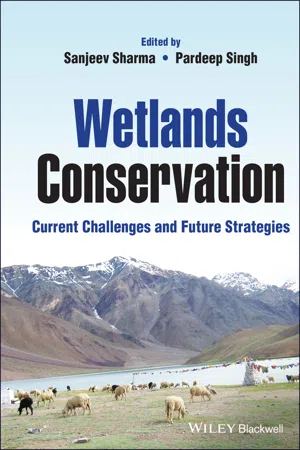
Wetlands Conservation
Current Challenges and Future Strategies
- English
- ePUB (mobile friendly)
- Available on iOS & Android
Wetlands Conservation
Current Challenges and Future Strategies
About This Book
Wetlands Conservation
An up-to-date overview of approaches for addressing wetlands degradation and its effects on ecosystem services, human health, and other ecosystems
Wetlands are essential sources of biodiversity, water purification, groundwater replenishment, flood control, storm protection, sediment retention, recreation and tourism, and more. Human exploitation of natural resources over the past 200 years has caused significant wetlands degradation and loss. Although the Ramsar Convention of 1971 drafted polices for wetland conservation and responsible use, many wetland sites remain inadequately conserved or managed. Maintaining the ecological balance and equilibrium of wetlands requires a clear understanding of the vital role of wetlands, the difficulties they face, and the policies enacted for their protection.
Wetlands Conservation: Current Challenges and Future Strategies summarizes both current and emerging management strategies, trends, and policies regarding wetlands protection around the world. The authors provide accurate scientific information on wetlands while discussing the effects of climate change, global warming, modernization in agriculture, and other key topics. Designed to assist in the development of future solutions for wetlands conservation and management strategies, this important volume:
- Highlights the environmental, socioeconomic, and cultural importance of wetlands
- Identifies the factors responsible for the failure of many conservation initiatives
- Describes the natural and anthropogenic factors of wetlands degradation
- Discusses the role of community-based wetlands conservation and management
- Explores Ramsar wetlands conservation and its impacts worldwide
Wetlands Conservation: Current Challenges and Future Strategies is an invaluable resource for graduate and postgraduate students, researchers, ecologists, policymakers, conservation organizations, and others working in the field of natural resources management.
Frequently asked questions
Information
1
Global Wetlands : Categorization, Distribution and Global Scenario
1.1 Wetlands Definition, Categorization and Classification Criteria
“Areas of seasonally, intermittently, or permanently waterlogged soils or inundated land, whether natural or otherwise, fresh or saline.”
“Land that is saturated with water long enough to promote wetland or aquatic processes as indicated by poorly drained soils, hydrophytic vegetation, and various kinds of biological activity which are adapted to a wet environment.”
“Permanently or intermittently wet areas, shallow water, or land water margins that support a net ecosystem system of plants and animals that are adapted to wet conditions.”
“Lands transitional between terrestrial and aquatic systems where the water table is usually at or near the surface or the land is covered by shallow water.”
1.1.1 Wetlands‐ Categorization and Classification
- Hydrology that causes wet or flooded soils
- Soils influenced by anaerobic processes and
- Life forms, especially rooted vascular plants, adapted to life in flooded ecosystems
- Tidal Marshes: Tidal marshes are commonly found near the shorelines and have high salt content. They sequester millions of tonnes of carbon every year...
Table of contents
- Cover
- Table of Contents
- Title Page
- Copyright Page
- Preface
- List of Contributors
- 1 Global Wetlands
- 2 Ramsar Convention
- 3 Ecological Importance of Wetland Systems
- 4 Ecological and Societal Importance of Wetlands
- 5 Recognizing Economic Values of Wetland Ecosystem Services
- 6 Ecosystem Services of Lagoon Wetlands System in India
- 7 Sustainable Practices for Conservation of Wetland Ecosystem
- 8 Assessing the Benefits, Threats and Conservation of Reservoir‐Based Wetlands in the Eastern Himalayan River Basin
- 9 Spatiotemporal Evaluation of Causes and Consequences of Wetland Degradation
- 10 The Status of Current Knowledge, Distribution, and Conservation Challenges of Wetland Ecosystems in Kashmir Himalaya, India
- 11 Heavy Metal Pollution in Coastal Environment and Its Remediation Using Mangroves
- 12 Mangrove Forests: Distribution, Species Diversity, Roles, Threats and Conservation Strategies
- 13 Wetland Conservation and Restoration
- Index
- End User License Agreement